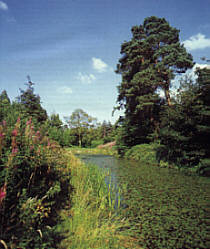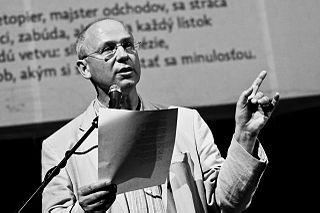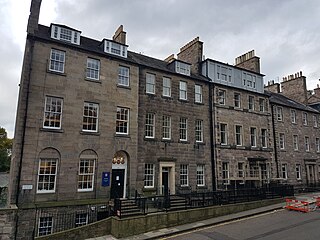Related Research Articles
Lallans, is a term that was traditionally used to refer to the Scots language as a whole. However, more recent interpretations assume it refers to the dialects of south and central Scotland, while Doric, a term once used to refer to Scots dialects in general, is now generally seen to refer to the Mid Northern Scots dialects spoken in the north-east of Scotland.

Christopher Murray Grieve, best known by his pen name Hugh MacDiarmid, was a Scottish poet, journalist, essayist and political figure. He is considered one of the principal forces behind the Scottish Renaissance and has had a lasting impact on Scottish culture and politics. He was a founding member of the National Party of Scotland in 1928 but left in 1933 due to his Marxist–Leninist views. He joined the Communist Party of Great Britain the following year only to be expelled in 1938 for his nationalist sympathies. He would subsequently stand as a parliamentary candidate for both the Scottish National Party (1945) and British Communist Party (1964).

Biggar is a town and former burgh in South Lanarkshire, Scotland, in the Southern Uplands near the River Clyde on the A702. The closest neighbouring towns are Lanark, Peebles and Carluke.

Whalsay is the sixth largest of the Shetland Islands in the north of Scotland.

Neil Miller Gunn was a prolific novelist, critic, and dramatist who emerged as one of the leading lights of the Scottish Renaissance of the 1920s and 1930s. With over twenty novels to his credit, Gunn was arguably the most influential Scottish fiction writer of the first half of the 20th century.
The Scottish Renaissance was a mainly literary movement of the early to mid-20th century that can be seen as the Scottish version of modernism. It is sometimes referred to as the Scottish literary renaissance, although its influence went beyond literature into music, visual arts, and politics. The writers and artists of the Scottish Renaissance displayed a profound interest in both modern philosophy and technology, as well as incorporating folk influences, and a strong concern for the fate of Scotland's declining languages.

Violet Jacob was a Scottish writer known especially for her historical novel Flemington and for her poetry, mainly in Scots. She was described by a fellow Scottish poet Hugh MacDiarmid as "the most considerable of contemporary vernacular poets".
The Black Isle is a peninsula within Ross and Cromarty, in the Scottish Highlands. It includes the towns of Cromarty and Fortrose, and the villages of Culbokie, Jemimaville, Rosemarkie, Avoch, Munlochy, Tore, and North Kessock, as well as numerous smaller settlements. About 12,000 people live on the Black Isle, depending on the definition.

William Soutar was a Scottish poet and diarist who wrote in English and in Braid Scots. He is known best for his epigrams.

Broughton is a village in Tweeddale in the historical county of Peeblesshire in the Scottish Borders council area, in the south of Scotland, in the civil parish of Broughton, Glenholm and Kilbucho and Upper Tweed Community Council. Broughton is on the Biggar Water, near where it flows into the River Tweed. It is about 7 km east of Biggar, and 15 km west of Peebles.

Biggar Museum Trust (BMT) is an independent charity based in and around the town of Biggar in South Lanarkshire, Scotland. The late Brian Lambie began a remarkable collection of artefacts from the area over some 40 years, and with a number of others created BMT which became responsible for a number of museums. It became apparent to the Trustees that the buildings were not able to meet modern requirements, were difficult to access and expensive to maintain and develop.
Professor Duncan Munro Glen was a Scottish poet, literary editor and Emeritus Professor of Visual Communication at Nottingham Trent University. He became known with his first full-length book, Hugh MacDiarmid and the Scottish Renaissance. His many verse collections included from Kythings and other poems (1969), In Appearances (1971), Realities Poems (1980), Selected Poems 1965–1990 (1991), Selected New Poems 1987–1996 (1998) and Collected Poems 1965–2005 (2006). His Autobiography of a Poet appeared with Ramsay Head Press in 1986. He edited Akros magazine for 51 numbers from August 1965 to October 1983. His work to promote Scottish poets and artists included Hugh MacDiarmid and Ian Hamilton Finlay, among others. Some of his poetry was translated into Italian.

Cammo is a northwestern suburb of Edinburgh, the capital of Scotland. It is south of A90, at the edge of the city, approximately 6 miles from the city centre.
James Robertson is a Scottish writer who grew up in Bridge of Allan, Stirlingshire. He is the author of several short story and poetry collections, and has published seven novels: The Fanatic, Joseph Knight, The Testament of Gideon Mack, And the Land Lay Still, The Professor of Truth, and To Be Continued… and News of the Dead. The Testament of Gideon Mack was long-listed for the 2006 Man Booker Prize.

W. N. Herbert, also known as Bill Herbert is a poet from Dundee, Scotland. He writes in both English and Scots. He and Richard Price founded the poetry magazine Gairfish. He currently teaches at Newcastle University.

The Scottish Poetry Library is a public library specialising in Scottish poetry. Since 1999, the library has been based at 5 Crichton's Close, just off the Canongate in Edinburgh's Old Town.

The Castalian Band is a modern name given to a grouping of Scottish Jacobean poets, or makars, which is said to have flourished between the 1580s and early 1590s in the court of James VI and consciously modelled on the French example of the Pléiade. Its name is derived from the classical term Castalian Spring, a symbol for poetic inspiration. The name has often been claimed as that which the King used to refer to the group, as in lines from one of his own poems, an epitaph on his friend Alexander Montgomerie:

The School of Scottish Studies was founded in 1951 at the University of Edinburgh. It holds an archive of approximately 33,000 field recordings of traditional music, song and other lore, housed in George Square, Edinburgh. The collection was begun by Calum Maclean - brother of the poet, Sorley MacLean - and the poet, writer and folklorist, Hamish Henderson, both of whom collaborated with American folklorist Alan Lomax, who is credited as being a catalyst and inspiration for the work of the school.

Angus Folk Museum was a centre for agricultural history and rural life located near Forfar, Angus. It was located in the village of Glamis off the A94. The museum was founded by Jean, Lady Maitland who gave her collections to the nation in the 1950s. Since 1976 it has been administered by the National Trust for Scotland. The museum has been described as containing "one of Scotland's finest folk collections".
References
- ↑ "Biggar Museum Trust". Archived from the original on 15 October 2012. Retrieved 3 October 2012.
- ↑ "Brownsbank Cottage" . Retrieved 3 October 2012.[ permanent dead link ]